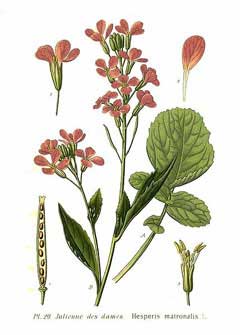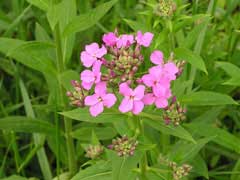 |
|
http://commons.wikimedia.org/wiki/File:29_Hesperis_matronalis_L.jpg |
 |
| http://commons.wikimedia.org/wiki/User:SB_Johnny |
Translate this page:
Summary
Bloom Color: Pink, Purple, White.
Main Bloom Time: Mid summer. Form: Upright or erect.
Physical Characteristics

 Hesperis matronalis is a PERENNIAL growing to 0.8 m (2ft 7in) by 0.6 m (2ft) at a medium rate.
Hesperis matronalis is a PERENNIAL growing to 0.8 m (2ft 7in) by 0.6 m (2ft) at a medium rate.
See above for USDA hardiness. It is hardy to UK zone 3 and is not frost tender. It is in flower from May to July, and the seeds ripen from June to August. The species is hermaphrodite (has both male and female organs) and is pollinated by Bees, flies, Lepidoptera (Moths & Butterflies).
It is noted for attracting wildlife.
Suitable for: light (sandy), medium (loamy) and heavy (clay) soils, prefers well-drained soil and can grow in nutritionally poor soil. Suitable pH: neutral and basic (mildly alkaline) soils and can grow in very alkaline soils.
It can grow in semi-shade (light woodland) or no shade. It prefers dry or moist soil and can tolerate drought.
UK Hardiness Map
US Hardiness Map
Synonyms
Plant Habitats
Woodland Garden Sunny Edge; Dappled Shade; Hedgerow;
Edible Uses
Edible Parts: Leaves Oil Seed
Edible Uses: Oil
Young leaves - raw. Rich in vitamin C, they are used as a cress substitute in salads[183, 244]. A rather bitter flavour, though many people like the extra tang it gives to salads[244]. For culinary purposes, the leaves should be picked before the plant flowers[183]. The seed can be sprouted and added to salads[183]. The seed contains 50% of an edible oil - there is a potential for cultivation[74, 177].
References More on Edible Uses
Medicinal Uses
Plants For A Future can not take any responsibility for any adverse effects from the use of plants. Always seek advice from a professional before using a plant medicinally.
Diaphoretic Diuretic Vitamin C
The leaves are antiscorbutic, diaphoretic and diuretic[74, 244]. They are best harvested when the plant is in flower[244].
References More on Medicinal Uses
The Bookshop: Edible Plant Books
Our Latest books on Perennial Plants For Food Forests and Permaculture Gardens in paperback or digital formats.

Edible Tropical Plants
Food Forest Plants for Hotter Conditions: 250+ Plants For Tropical Food Forests & Permaculture Gardens.
More

Edible Temperate Plants
Plants for Your Food Forest: 500 Plants for Temperate Food Forests & Permaculture Gardens.
More

More Books
PFAF have eight books available in paperback and digital formats. Browse the shop for more information.
Shop Now
Other Uses
References More on Other Uses
Cultivation details
Landscape Uses:Border, Massing, Specimen, Woodland garden. Prefers a rich moist well-drained soil, succeeding in full sun or semi-shade[111, 244]. Requires a neutral to alkaline soil[200]. Prefers an alkaline soil[190]. Tolerates poor soils[200, 233]. Grows well in damp, shady or grassy places[187]. Established plants are drought resistant[190]. Plants are hardy to about -20°c[187]. A very ornamental plant[1], it is a short-lived perennial[187] and is often grown as a biennial. A good bee, butterfly and moth plant, it is a specific food plant for the orange-tip butterfly[17, 30, 200]. The flowers are very aromatic with a clove-like fragrance, this is especially apparent in the evening[188, 245]. They usually have very little scent during the day and thus obtained a reputation in folk-lore for deceit[244]. The plant is sometimes cultivated for the essential oil contained in its seed[61]. Special Features:Not North American native, Naturalizing, Attracts butterflies, Suitable for cut flowers, Fragrant flowers.
References Carbon Farming Information and Carbon Sequestration Information
Temperature Converter
Type a value in the Celsius field to convert the value to Fahrenheit:
Fahrenheit:
The PFAF Bookshop
Plants For A Future have a number of books available in paperback and digital form. Book titles include Edible Plants, Edible Perennials, Edible Trees,Edible Shrubs, Woodland Gardening, and Temperate Food Forest Plants. Our new book is Food Forest Plants For Hotter Conditions (Tropical and Sub-Tropical).
Shop Now
Plant Propagation
Seed - sow spring in an outdoor seedbed and plant them out in late summer[111]. Germination should take place within 3 weeks. The seed can also be sown in early spring in a warm greenhouse. When large enough to handle, prick the seedlings out into individual pots and plant them out in late spring. The seed can also be sown in July for planting out in the following spring. Division. Plants are short-lived perennials, division may not be worthwhile. Cuttings in summer 7cm long in a shady border[111]. Only done with named varieties being grown for ornament, it is not worthwhile otherwise.
Other Names
If available other names are mentioned here
Native Range
TEMPERATE ASIA: Turkey, Russian Federation-Ciscaucasia (Ciscaucasia), Armenia, Azerbaijan, Georgia, Russian Federation (Dagestan), Kazakhstan, Kyrgyzstan, China (Xinjiang Uygur Zizhiqu) EUROPE: Austria, Hungary, Poland (south), Slovakia, Russian Federation-European part (European part (south)), Ukraine (incl. Krym), Albania, Bulgaria, Bosnia and Herzegovina, Greece (north), Croatia, Italy, North Macedonia, Montenegro, Romania, Serbia, Slovenia, Spain, France
Weed Potential
Right plant wrong place. We are currently updating this section.
Please note that a plant may be invasive in one area but may not in your area so it's worth checking.
Conservation Status
IUCN Red List of Threatened Plants Status :

Growth: S = slow M = medium F = fast. Soil: L = light (sandy) M = medium H = heavy (clay). pH: A = acid N = neutral B = basic (alkaline). Shade: F = full shade S = semi-shade N = no shade. Moisture: D = dry M = Moist We = wet Wa = water.
Now available:
Food Forest Plants for Mediterranean Conditions
350+ Perennial Plants For Mediterranean and Drier Food Forests and Permaculture Gardens.
[Paperback and eBook]
This is the third in Plants For A Future's series of plant guides for food forests tailored to
specific climate zones. Following volumes on temperate and tropical ecosystems, this book focuses
on species suited to Mediterranean conditions—regions with hot, dry summers and cool, wet winters,
often facing the added challenge of climate change.
Read More
Expert comment
Author
L.
Botanical References
45200
Links / References
For a list of references used on this page please go here
Readers comment
© 2010, Plants For A Future. Plants For A Future is a charitable company limited by guarantee, registered in England and Wales. Charity No. 1057719, Company No. 3204567.